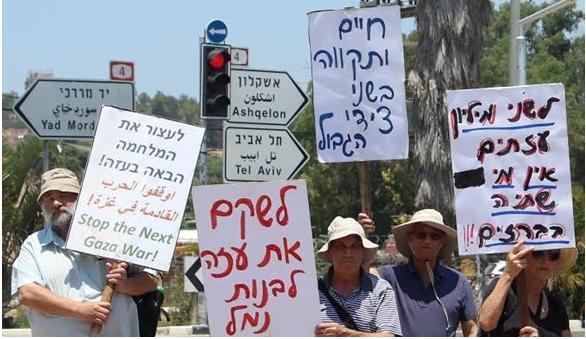The number of exits by Palestinians through the Erez Crossing, between Israel and the Gaza Strip, dropped by 55 percent in the first half of this year compared to the same period in 2016. The monthly average was only 6,302 exits in the first half of 2017, compared to a monthly average of more than 14,000 exits in the first half of 2016.

Protestors demonstrate against the siege of Gaza at the Yad Mordechai Junction in the south of Israel. Among the placards are calls to “Rehabilitate Gaza and build a port”; “2,000,000 Gazans have no drinking water in their faucets!!!”; “Life and hope on both sides of the border” (Photo: Other Voice)
The monthly average number of exits in the first half of 2017 was similar to the monthly average recorded in 2014 (6,270). It was toward the end of 2014, following Israel’s devastating military operation, Protective Edge, that understandings were reached which resulted in increased entrances into Israel via the Erez Crossing. According to the Israeli NGO Gisha “There was a slight expansion of the criteria for travel from Gaza as well as a tendency to allow more people to travel in the categories that already existed (medical patients and their companions, merchants, and ‘exceptional humanitarian cases’). The number of exits has been declining for some time now, reversing the minor improvements in policy made back in 2014. Even 14,000 exits was still just a tiny fraction of the more than half a million recorded in the first half of the year 2000, for example.”
Recently, the Palestinian Authority has also been playing a negative role, particularly regarding the decline in travel for medical patients in need of treatment that is not available in Gaza. In June 2017, only 1,728 exits by medical patients and their companions were recorded. This is the lowest number registered since September 2014 (with the exception of October 2016, when the crossing operated only intermittently during the Jewish High Holidays). By comparison, 2,923 exits by medical patients and companions were recorded a year before, in June 2016 – a decline of 40 percent. Human rights organizations in the Gaza Strip say that the number of referrals issued to Gaza residents by the Palestinian Authority for treatment in the West Bank and Israel has dropped. These referrals are a prerequisite for filing an application for an exit permit. Still, even allowing for the decrease in the number of applications submitted to the Israeli authorities, the rates of response and approval are still exceedingly low.
Economic activity is also impacted by the movement of people and here too there has been a decline. A monthly average of 2,499 exits by merchants was recorded during the first half of 2017, a 64 percent drop compared to June 2016. The overall total number of exits recorded at Erez Crossing increased slightly in June, compared to the low numbers recorded in previous months, but this can be accounted for by travel for prayers at al-Aqsa Mosque in Jerusalem, which was temporarily permitted, albeit in a limited manner during the month of Ramadan. This was the first time this year that travel for prayers at al-Aqsa was permitted.
According to Gisha “These numbers can only mean one thing: A tightening of the closure on Gaza. The right to freedom of movement is being violated and medical patients’ lives are being put at great risk. Gaza residents’ rights – to see their family members, earn a living, develop professionally, study, and thrive – are being denied. This tightening of the closure is not only a breach of Israel’s responsibility, as the occupying power, to protect human rights and maintain normal life in Gaza. It also stands in contradiction to the rhetoric used by government officials in Israel, which recognizes that reconstruction in Gaza, development, and well-being are squarely within Israel’s own interests, including for security.”
Two peace and social movements “Standing Together” and “Other Voice” will protest next Friday, August 4, at Yad Mordechai Junction, near Erez Crossing against the siege of Gaza by Israel. “Other Voice” is a civil movement of Israelis from communities near the Gaza Strip and Palestinians from the Gaza Strip “working together to build good neighbor relationships and dialog on both sides of the fence, call to end the endless cycle of violence and support a long lasting political solution in the region.”


